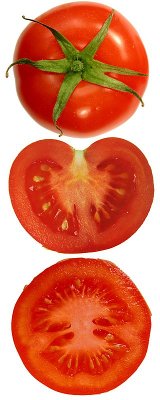Tomato
Scientific Name: Solanum lycopersicum
Climate: Cool and warm
Plant Description: The tomato is a red berry plant of the nightshade family. It grows up to three meters in height. It has many branches, which are usually weak and need support. It has compound, hairy leaves, which can reach up to 45 cm in length, and they have a strong smell. The flowers are small and yellow, with five petals, and grow in hanging clusters. The fruits or berries are generally red and can grow up to 7 cm in diameter. Although technically a fruit, the tomato is commonly considered a vegetable as it is used mostly in salty rather than sweet dishes. There are over 10,000 different varieties of tomatoes, so they can have a variety of colours and shapes.
The most important difference to be aware of between tomato plants is the difference between determinate and indeterminate. Determinate tomatoes are so called because they grow to a predetermined height, usually about a meter, and stop growing when flowers and fruits are produced at their tip. These are usually cultivated as an annual crop. Tomatoes of this variety tend to ripen around the same time over a two-week period. They do not need much support to grow and can be grown in pots or indoors. These tend to be hybrid tomatoes. Indeterminate tomatoes are more closely related to their ancestors and can therefore be cultivated as a perennial. They can flower and produce fruit throughout the season. Their flowers grow on side branches but not on the tips. These plants can grow up to three meters and need support.
Cultivation: Tomatoes can be grown almost anywhere and are the world’s third largest crop after potatoes and onions. They can be grown in a range of soils but grow best in deep, well-drained, slightly acidic ones. Tomatoes do not tolerate frost and grow best in direct sunlight, so they should receive at least six hours of sunlight per day.
If you are growing tomatoes in areas affected by frost, they should be planted indoors about six or eight before the last frost appears. They can then be transplanted after this. Compost should be added to the soil before planting. It is also a good idea to harden the young plants by leaving them outdoors for a few hours each day for about a week before transplanting if they have been sprouted indoors. Stakes or frames should be placed to support the growth of the plants at this moment to prevent damage to the roots later. After transplanting, the plants require watering to allow the roots to take hold and prevent wilting.
Tomatoes require abundant water during the growing season. They are best watered early in the morning and should not be watered in the afternoon or evening. Applying organic mulch is a good way to maintain moisture in the soil and prevent weeds.
It is not necessary to prune determinate tomatoes, but the indeterminate type can benefit from the removal of suckers near the base of the plant, as this can promote growth and also ensures that the plants will not touch the ground and reduce the risk of pests and diseases.
Harvesting will depend on whether you cultivate determinate or indeterminate tomatoes as explained above. Basically, the tomatoes are ready to pick when they have obtained a deep colour and are firm. They can be preserved in a variety of ways.
 Uses: Tomatoes are eaten raw in salads, as a cooked vegetable, they can be pickled, sundried, or used in juices, soups, sauces, and purees.
Uses: Tomatoes are eaten raw in salads, as a cooked vegetable, they can be pickled, sundried, or used in juices, soups, sauces, and purees.
Tomatoes contain antioxidants, which some studies indicate reduce the risk of heart disease and several cancers. They are also good for the skin. They are an excellent source of vitamins C and K, and potassium. Potassium can widen the arteries, ease the flow of blood, and help regulate blood pressure. Tomatoes are about 95% water and the other 5% contains carbohydrates and fiber.
Pests and Diseases: The most common pest that affects the tomato is the aphid. Ladybugs are a good natural method of controlling aphids. The leaves can also be cleaned with soapy water. This is also an effective method of controlling the tomato horn worm, which is a large caterpillar, and white flies. Slugs and snails can be prevented by placing dishes with beer in or around the plants.
A number of diseases can affect the tomato. These include bacteria, blight, mildew, wilt, and root rot. Many of these diseases can be avoided by ensuring that the tomatoes are planted in healthy soil, that they have sufficient space to ensure that the plants have plenty of air circulation, and that they are irrigated correctly.
References:
http://agropedia.iitk.ac.in/content/climatic-and-temperature-requirement-tomato
https://www.britannica.com/plant/tomato
https://sodelicious.recipes/in-the-kitchen/the-most-popular-tomato-types/
https://www.gardenguides.com/info_12072440_annual-vs-perennial-tomatoes.html
https://www.tomatofest.com/tomato_questions_s/128.htm
https://agricultureguruji.com/tomato-cultivation/
https://www.almanac.com/plant/tomatoes#
https://www.healthline.com/nutrition/foods/tomatoes#benefits
https://gilmour.com/tomato-problems-diseases-pests
En español: Tomate

